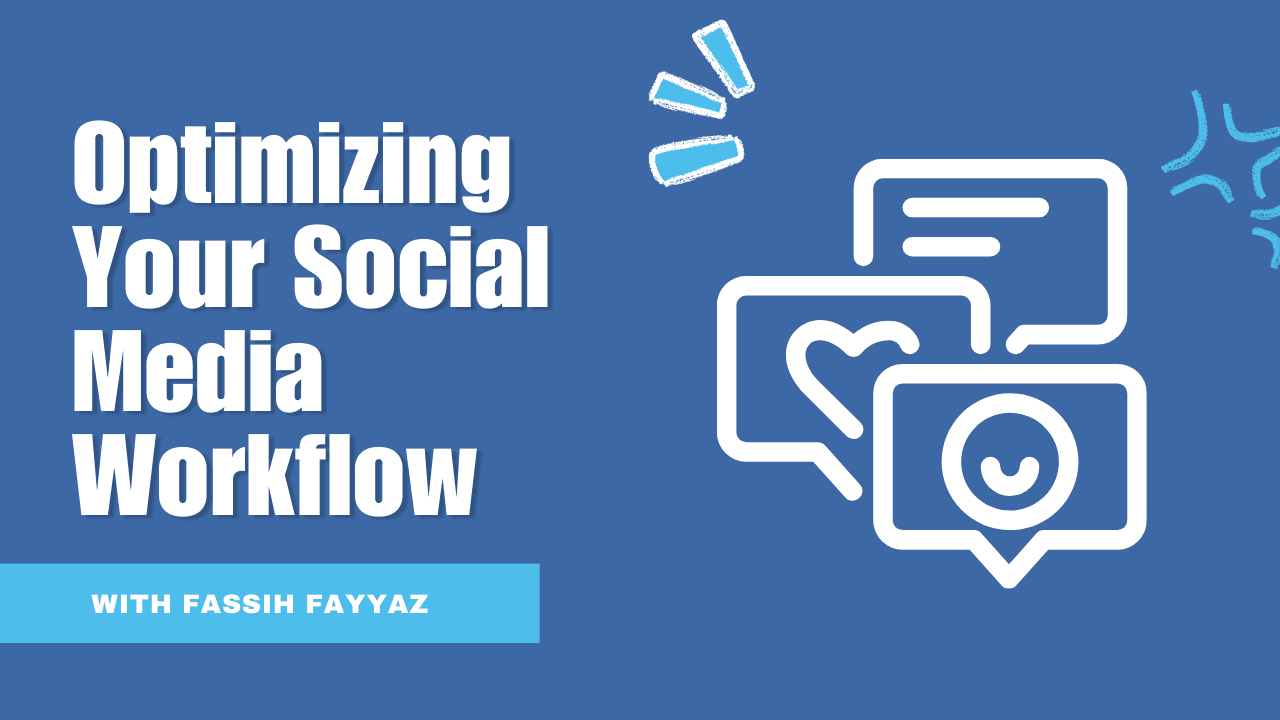In the fast-paced world of digital marketing, a well-structured social media workflow is not a luxury—it’s a necessity. So, what exactly is a social media workflow? It’s a systematic and repeatable process that encompasses planning, creating, publishing, monitoring, analyzing, and interacting with content across various social media platforms.
Adopting a scalable social media workflow provides three key benefits:
- More time for creativity and strategy by reducing repetitive tasks
- More quality control checkpoints through structured review and approval processes
- More opportunities for collaboration between team members through centralized systems
In this article, we’ll dive into the value of streamlining your social media workflow and how tools like Sprout Social can optimize the key stages – from scheduling and publishing to reporting and engagement.
Table of Contents
The Importance of an Efficient Social Media Workflow
With social media growing more complex, having an efficient workflow is crucial for brands to manage multi-channel social media strategies. The right workflow allows you to scale your efforts and increase productivity.

Benefits of a Social Media Workflow
A well-crafted social media workflow brings structure to the chaos of social media management. It enables you to streamline your processes, maintain consistency across platforms, ensure quality control, and effectively engage with your audience.
- Saves time – A defined workflow minimizes redundant tasks through automation and streamlining. This gives you more time for high-value work like creating compelling content.
- Improves quality – Established review and approval steps enhance quality control. Content goes through the necessary checks before publishing live.
- Increases collaboration – Centralized systems like shared calendars improve transparency and teamwork. Everyone has visibility into the content schedule.
- Boosts productivity – Structured workflows maximize output and impact. Teams can achieve more together through organized systems.
- Enables measurement – Reporting processes capture key analytics and insights systematically. You can consistently track and demonstrate ROI.
Why You Need a Social Media Management Workflow
Social media is a critical component of marketing strategies. However, without a proper workflow in place, tasks can become overwhelming, leading to errors, missed deadlines, and inconsistent content. An efficient workflow eradicates these issues, ensuring that your social media presence remains strong, consistent, and impactful.
Deep Dive: The Value Added by a Streamlined Workflow
Streamlining your social media workflow pays dividends through time savings, quality control, and collaboration. Let’s explore some of the top benefits in more detail.

More Time for Creativity
When you streamline your social media workflow, you free up time for creative brainstorming and strategic planning—activities that can significantly enhance your social media presence.
More Quality Control Checkpoints
A structured workflow allows for more checkpoints in the content creation and posting process. This means errors can be identified and corrected promptly, ensuring the quality of your posts.
For example, an approval process with both legal and creative reviewing content adds more checkpoints. Automated rules can also flag posts with brand inconsistencies.
The right checks and balances improves the quality of your social content across the board. Prevention is cheaper than the cure – a solid workflow means fewer public missteps.
More Opportunities for Collaboration
A clear workflow fosters collaboration by defining roles and responsibilities. It allows team members to work together efficiently, share ideas, and make collective decisions.
Marketing, social media, sales, executives, and other stakeholders can all access the workflow. Real-time reporting keeps everyone looped in.
This level of collaboration leads to better ideas, feedback, and outcomes. Ultimately your social media presence benefits from multiple perspectives.
The Benefits of a Streamlined Social Media Workflow
A streamlined workflow, like those offered by Sprout Social, not only enhances efficiency but also improves the quality of your social media content, improves team collaboration, and ultimately boosts your overall social media presence.
In summary, optimizing your social media workflow offers:
- Time savings from less repetitive tasks and manual processes
- Quality control through structured approval and review checkpoints
- Increased collaboration with team-wide visibility and centralized systems
- Boosted productivity and efficiency to achieve more together
- Opportunities for optimization by consistently measuring performance
Different Types of Social Media Workflows
There are several types of social media workflows that you can adopt depending on the complexity of your operations:
Basic social media workflow
At a minimum, a straightforward workflow connects planning, creation, approval, scheduling, publishing, and analytics. Each step hands off cleanly to the next.
Typically planning happens in a social media content calendar. Content gets created based on the plan, then sent for review. Approved content gets scheduled and published, with reporting capturing results.
This basic workflow facilitates an efficient conveyor belt to coordinate teams executing social strategies.
Social media posting workflow
The posting workflow focuses specifically on the hand-off between creation, curation, approval, scheduling, and publishing of content.
This workflow provides structure around when and how content transitions to different stakeholders, and ultimately to social platforms.
Automation can also be built into the posting workflow – for example scheduling recurring posts or automatically publishing from pre-approved content libraries.
Social media approval workflow
The approval workflow sets up the specific process of submitting, reviewing, approving, and rejecting content for publication.
Often different team members are assigned specialized roles in the approval chain depending on content type and channel. Various permission and notification settings can customize workflows.
Structured approval steps improve quality control and accountability before content is scheduled and published live.
Content batching workflow
Batching organizes content creation into coordinated assemblies focused on specific campaigns, initiatives, or recurring content types.
For example, creating social posts, videos, and images around a product launch. Or batching 2 weeks worth of Instagram stories.
Batching allows for more efficient production by grouping related tasks. It also aids consistency when developing a cluster of coordinated assets.
How to Create and Optimize Your Social Media Workflow

Creating an efficient social media workflow involves several steps. Here are some tips to guide you:
Establish Roles and Responsibilities
Clearly define who is responsible for what. This includes content creation, approvals, scheduling, engagement, and analysis.
What About Specific Situations?
In the case of crisis management or negative feedback, have a plan in place. Determine who will be responsible for responding and how the situation should be handled.
What About Legal, HR, and Other Stakeholders? When Should They Be Involved?
Involving other departments, like legal or HR, depends on the content and the context. For instance, for content that might have legal implications or employee-related content, these departments should be involved.
Be Clear on the Rules of Your Industry
Every industry has rules regarding what can and cannot be posted. Make sure you’re familiar with these guidelines to prevent violations.
Use a Social Media Calendar to Plan Ahead
A social media calendar, like the one offered by ClickUp, allows you to schedule posts, visualize your content strategy, and ensure you’re posting consistently.
Make Sure Everyone Knows the Process
Every team member should understand the workflow. This includes knowing their roles and responsibilities and the sequence of actions in the workflow.
Stay Secure
Implement measures to protect your accounts. This includes using secure passwords, enabling two-factor authentication, and regularly updating your security settings.
Use a Unified Social Media Inbox
A unified inbox, like those offered by tools like Hootsuite or Sprout Social, allows you to manage all your social media interactions in one place.
Keep It Simple
While a detailed workflow is good, don’t over-complicate things. Keep your workflow simple and flexible to changes.
Be Flexible and Adapt as Needed
Social media is always evolving. Be ready to adjust your workflow as necessary to keep up with changes.
8 Best Practices for Creating an Effective Social Media Workflow
- Plan ahead – Use an editorial calendar to map out content strategy and specific posts.
- Create your social media strategy around your workflow – And not the other way around.
- Know your social media platforms – Optimize scheduling and engagement for each platform’s algorithm.
- Use a social media management tool for publishing, monitoring, reporting, and listening.
- Don’t skip over the approval process – Institute quality control checkpoints before content goes live.
- Have clear posting guidelines – Provide examples and templates for consistently on-brand content.
- Consider workflow diagrams – Visualize workflow steps and hand-offs for clarity.
- Continue optimizing – Regularly evaluate processes to identify bottlenecks and improvement areas.
VI. Tools to Improve Your Social Media Workflow
Several tools can help streamline your social media workflow, including:
- Social Media Workflow Tools: These include platforms like Hootsuite and Sprout Social, which offer features for scheduling, monitoring, and analytics.
- Google Sheets: It’s an excellent tool for creating a social media calendar and tracking your posts.
You can also streamline your workflow using specific tools for different stages of your workflow:
- Scheduling and Publishing Workflow: Tools like Hootsuite can automate scheduling and publishing of your posts.
- Content Approval Workflow: Tools like Planable can streamline the approval process.
- Reporting Workflow: Tools like Sprout Social offer automated reporting tools and data visualizations.
- Engagement Workflow: Tools like Hootsuite allow you to manage all your interactions in one place.
Moreover, you can automate your workflow with tools like Sprout Social and manage your content operations and track campaigns with ClickUp.
Audit Your Social Media Workflow
Regular audits can help optimize your social media workflow. Here are some tips:
- Identify Bottlenecks: Look for areas where tasks are getting delayed or quality is being compromised.
- Check Relevance: Make sure that your workflow is still relevant to your current operations and goals.
- Check for Updates: Social media platforms often roll out new features. Make sure your workflow takes advantage of these.
- Get Feedback: Ask your team for feedback on how the workflow can be improved.
FAQs about Social Media Workflow:
Here are some most frequently asked questions related to Social Media Workflow:
What is a social media workflow?
A social media workflow is a systematic process to manage your social media presence and interactions – including planning, creating, publishing, monitoring, analyzing, and engaging with content.
What is the workflow process of social media manager?
A typical social media manager workflow includes planning content in a calendar, creating content, submitting for approvals, scheduling approved content, publishing, monitoring engagement and analytics, then optimizing based on insights.
What are the different types of social media workflow?
Common social media workflows focus on posting, approval, content batching, publishing, community response, listening, analytics, and reporting.
What are the three steps of social media workflow?
The three core steps in any basic social media workflow are 1) Planning 2) Publishing and 3) Listening. Planning creates a content calendar. Publishing schedules and shares content. Listening monitors engagements and analytics.
Conclusion
Are you ready to make your workflow “work” for you? By implementing an effective social media workflow, you can improve efficiency, ensure consistency, enhance collaboration, and ultimately, become a better social marketer. Start optimizing your workflow today, and witness the transformation in your social media management.
This article is part of a series on social media management. Check out our reviews of various tools, including Hootsuite, Buffer, and Sprout Social. You can also learn about how to grow your newsletter with Twitter and how to recover a suspended Twitter account.




